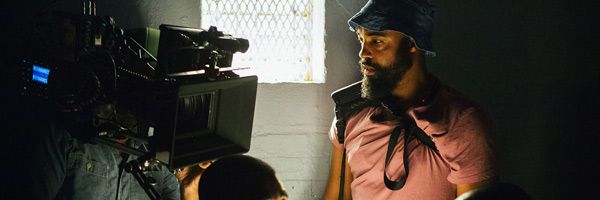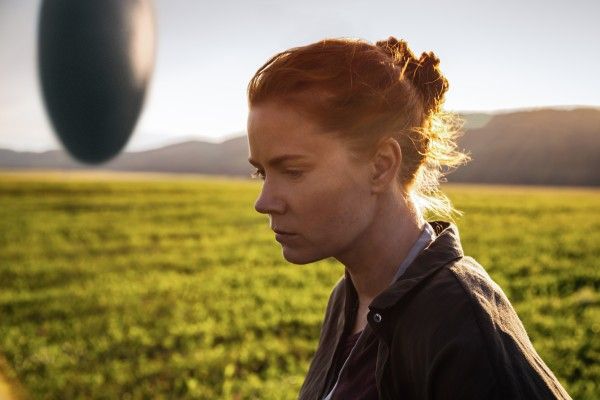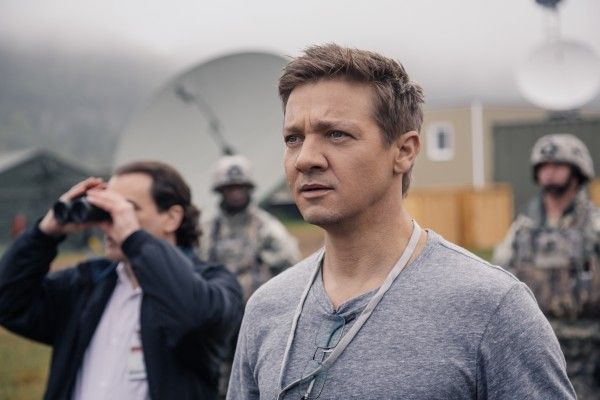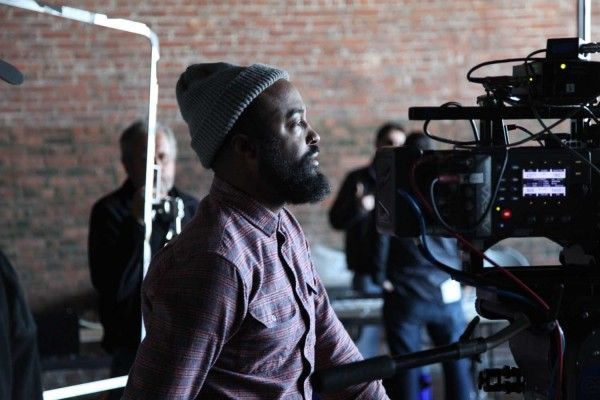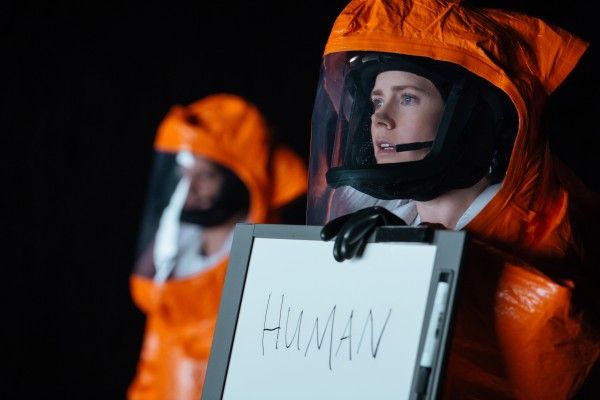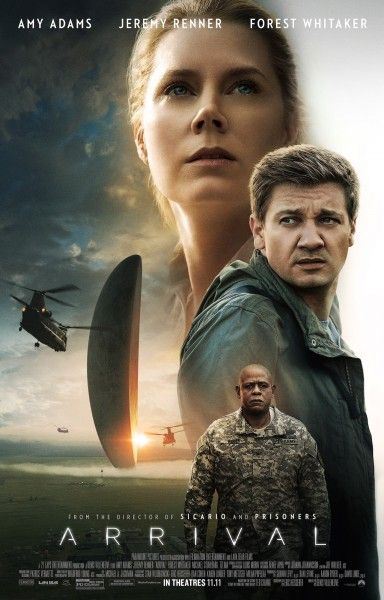Unique sci-fi stories are few and far between nowadays, but the upcoming film Arrival is a terrific, moving, and somewhat surprising entry in the genre. Based on a short story by Ted Chiang, the film marks the latest effort from Prisoners and Sicario director Denis Villeneuve and is a first contact story that favors intelligence over might. Amy Adams stars as a linguist who is enlisted to help try and figure out how to communicate with alien beings who have touched down across the planet. Together with a mathematician (Jeremy Renner), she sets out trying to make a connection with these aliens to figure out why they’re here, what they want, and what their intentions are. It's intellectually focused, smart sci-fi instead of an explosion-filled "us vs. them" story, which wildly refreshing.
However, while this sci-fi aspect of the story is compelling, Arrival is at heart a story about unpacking grief. Adams’ character is recovering from a troubling loss at the start of the film, and this deeply emotional journey grounds the picture with something profoundly human, resulting in a viewing experience that is universally affecting.
One of the secret weapons of Arrival is cinematographer Bradford Young, whose use of natural light, intense focus on character, and thematically appropriate visuals are a vital part of what makes Arrival so special. Young’s profile has been rising in recent years with spectacular work in films like Selma and A Most Violent Year, and he’s getting ready to shoot the untitled Young Han Solo film with directors Phil Lord and Chris Miller.
So in anticipation of Arrival’s release in theaters on November 11th, I recently got the chance to speak with Young about his work on the film and his craft in general. We discussed his working relationship with Villeneuve and how the two connected over the film’s emotional center, the experience of capturing images onscreen when the aliens aren’t physically there, and some of the biggest misconceptions people have about what cinematographers do. We also discussed his impending work on the Han Solo movie, what audiences can expect from that Star Wars spinoff, and how Lord and Miller convinced him to sign on. It’s a fascinating discussion with one of the best cinematographers working today about one of the best films of the year, so hopefully you’ll get as much joy out of reading the interview as I did conducting it. Read on below.
I was curious what were your first conversations with Denis [Villeneuve] like? How early on did you come on this project?
BRADFORD YOUNG: Well I’m not sure how early in the process. I mean they were already doing some work he and and Patrice already were well into thinking about what the film could be when I came in. So there was some real serious groundwork being laid, but yeah, you know the first conversations with Denis were like, “Hey man, I’m a big fan. I’ve seen every movie you’ve ever made. I can’t wait to see Sicario. I really believe in what you do I’m a really big supporter of your practice as an artist and whatever material you have I’d love to find a way to wedge myself into the equation.” And we just have a genuine respect for one another and that sort of lead the way. Yeah, so it was just really about we respect each other and no matter what the material was, I think we generally thought that there would be something that we could do that was to be determined. Then it became about the material and the material just was a bonus. There was a lot we could extract from the material just on a level of storytellers but also human beings and parents, and you know those things really stuck to us. I think that was really sort of the catalyst; we’re both parents and we have our own questions parents about our own children. We’re wrestling with our own mortality, the mortality of our children these are all things that we think about that you don’t want to think about, and how can we really take that sensitivity and that vulnerability and bring it into the movie. That really felt, just based on both of our bodies of work, that we could do that together and that’s how the exploration began.
Yeah, the film is obviously sci-fi and it’s dealing with aliens but it’s very much a character drama about unpacking grief. So visually speaking…
YOUNG: I like that. I like that, unpacking grief I haven’t heard that one yet. That’s it, you said it. Unpacking grief that’s really very important.
Well in dealing with sci-fi you’re dealing with aliens, obviously, but at heart this is a grief drama. So cinematically speaking, what was it like to try and meld those two things together and make it dynamic, make it cinematic but also ensure that you’re sticking to these characters and sticking to the drama of it all?
YOUNG: Well I think the film can’t go in like four different directions, right? It has layers so it’s not monolithic but it has to go in one direction. I think for us it was important to figure out whose perspective the story was from, and that didn’t need much figuring out because we realized it’s all about Louise (Amy Adams.) Once we established that, everything else sort of fell into place. Once we said this film was about flesh and bone, it’s about the human beings in the foreground and our perspective on the aliens is her perspective and our journey is determined by her—our journey as an audience, our journey as a filmmaker is determined by her—that sort of anchored everything and it really helped us make what Denis would call’ “dirty sci-fi” or just a film that feels like a regular Tuesday morning when aliens show up. Those things you can’t make up; there’s no way to show that feeling or create that feeling in the film unless you’re anchored in humanity and part of that is reminding us that human beings have agency and their own likeness. When you do that, that sort of really determined how the visual landscape of the film and how we moved that film forward visually. So the science fiction part of it was I think less about the aliens and more about creating mythology within the mundane, and that happened to be lead by aliens and spacecraft. This constant negotiation, this push and pull between the known and the unknown, the us and the other and those are classic science fiction tropes that you really can’t divorce yourself from. Those are the shackles of science fiction that you really kind of are willing to keep on. But the other stuff just didn’t really apply, like these aliens didn’t have two feet and arms, they didn’t have guns and blasters—that aspect of the film we didn’t really want to make. We’re trying to make something different, something slightly more grounded about humanity.
Your previous work is incredible, but with films like Selma and A Most Violent Year you’re working with actors and real things on the day. I’m curious from a practical standpoint, how did you go about setting up shots with aliens that aren’t there and using this strong light but also kind of feeling their presence through the camera?
YOUNG: Well again that is a really good question because again you’re inside the spaceship, you’re just that light that’s in the ship that was perfectly crafted and designed into the set that [production designer] Patrice [Vermette] and Denis forged. You know you didn’t want to portray that with blue screen or take that away. You had to let that black box be saturated with that light because that light has so much vibration. So much to say, so much to tell us about our characters, so anything that got in the way of that just seemed sort of counterproductive to the kind of film we were trying to make. In terms of her seeing the aliens you just employ those basic tools where we had guys behind the screen who were holding sticks that were about the same height that our aliens would be, not height but the same height as their hands, as their feelers. We would just make a little indentation on the screen and that would give Amy [Adams] and Jeremy [Renner] and all the other characters an eyeline. That’s the hard part, I can’t even imagine being an actor and having to talk to a tennis ball; that shows you really how brilliant those actors are. This required a lot of imagination but again as long as you’re not betraying the core of what needs to be present, you know you’re not going to take away later. As long as you’re honoring that then everything else falls into place. You gotta give actors real light interactions, that’s my belief. Given them real light, real-time interactions so that we can feel the effect.
We have a pretty big cinephile readership so I wanted to ask just kind of generally, what is the biggest misconception of what a cinematographer does?
YOUNG: Oh that’s a good question, someone asked me that question yesterday. I don’t know, I think our work isn’t only about seeing it’s about organizing too. It’s about helping folks make sense of the individual pieces that will be brilliantly organized by an editor later. We determine a lot of the pacing and the rhythm, and the structure and the visual landscape of a film. So it’s more managerial in a healthy way, not in a pejorative way, but in a healthy way it’s more managerial than just me saying, “I want the camera to be here and I want the lights to be here.” You have to be highly organized; we’re wearing a lot of hats. But also at the same time it’s like cinematographers are vessels. A good cinematographer to me that has no personal agenda just he or she is a vessel of an idea that was inoculated into them by a director. In this era of like famous rockstar cinematographers I think we forget that a cinematographer is only as good as the material and definitely is only enabled by a great director and is held up by an incredible production designer, costume designer—it’s a sum of all parts, it’s highly collaborative.
When you were growing up and growing in your field, who were some of the cinematographers you were looking to for inspiration and kind of looking up to?
YOUNG: Oh man, Ernest Dickerson, Arthur Jafa, Malik Sayeed, Johnny Simmons, Harris Savides, Gordon Willis, Michael Chapman, Mark Lee Ping Bing, Chris Doyle, Owen Roizman, Ellen Kuras, the list is long. Vittorio Storaro, I mean the list goes on, and on, and on but yeah all these masters of the dark of the unseen Fred Elmes, you know, Robby Mueller, Bob Elswit, to the cast they’re really just blowing me away man.
Do you prefer a natural light? I mean the locations in this film are pretty gorgeous it seems like there was quite a bit of opportunity there.
YOUNG: Yeah, yeah, yeah every film requires a different stroke of light but yeah I mean I’m a big proponent of keeping film technology out of the way because the universe gives us so many gifts. If there’s a lighting that always doesn’t always look good you can avoid that or shape it or craft it or help motivate it in what ways you should. But yeah I like to start from scratch, when I say start from scratch doesn’t mean a black box. It means what space is getting their fair share of good available light and how can I help shape that and determine that so it helps speak to our story. If that can’t be done then I use lighting tools as if they were bits and pieces of natural light.
Well in hindsight now it kind of feels like Arrival might have been kind of a warm up to your next project, which is the Han Solo film with Phil Lord and Chris Miller. Are you excited, nervous to work on such a massive canvas?
YOUNG: Both excited and real nervous, yeah it’s gonna be an interesting film the collaboration is going to be very interesting.
Well what seems to be really encouraging about this new batch of Star Wars is Lucasfilm seems eager to let filmmakers express their unique visions rather than fitting into a mold. You know Abrams brought on Dan Mindel, and Rian Johnson with Steve Yedlin. So I was curious what have your conversations with [Phil] Lord and [Christopher] Miller been like so far cause their track record is pristine.
YOUNG: “It’s funny, here’s the thing about Phil Lord and Chris Miller: don’t let their track record fool you. Don’t put those guys in a box because they have a vision, they know exactly what they want. They have no hidden agenda, but they do have an agenda; they have a way of seeing that’s very special, and their collaboration is genuinely unique. So I have to say I had to get converted into that. I respect their work, I respect them as filmmakers, but I wasn’t quite sure if there would be a good marriage between what I’m trying to pursue and the work that I’m doing and what they’re doing, but they helped make that real clear to me early on by expressing some real interesting story [and] photographic ideas that really resonated with me. So once they started really pulling me into that world, I realized how much these cats have come from the same pedagogy of filmmaking—in the visual sense for sure, and definitely from an approach in terms of how we want to make movies, they come from the same school. These cats are subversive, don’t let it fool you. They are prepared, they are prepared to say exactly what they want to say and it’s complex and it’s layered, it’s smart, it’s visual, it’s dramatic, it’s funny, it’s uneasy, it’s unexpected. I’m honored to have them in the list of directors that I’ve worked with, that’s for sure.
Obviously this film takes place before A New Hope. Are you looking towards the aesthetic that Lucas put there or are you guys kind of able to craft your whole different idea of this that we haven’t seen before?
YOUNG: Yeah, nah we’re doing our own thing, that’s why we’re there. Phil and Chris are there to bring what they bring to their films, their very unique vision, their perspective on story and they asked me to come bring what I bring, and so just for that it won’t feel like any of the other films. And nobody at Lucasfilm is asking us to betray that, they’re saying ‘We’re in full support of what you do and we wanna make sure that we’re able to help you do it in the best way.’ It’s gonna feel like a Star Wars film, but we’re definitely gonna break some rules, and we’re encouraged to do that. Visually, narratively that’s a good mandate. They really are about, from what I’ve seen so far, supporting up and coming artists, artists who have a strong vision and voice and perspective, and they really wanna permeate the films with those kinds of voices. So it’s interesting, very interesting. Not what I thought it would be, that’s for sure. I’m pleasantly encouraged and pleasantly surprised.”

